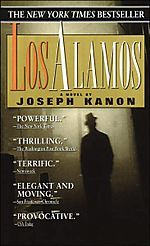FFB: Los Alamos
 Since the hubster has a physics background and has long been fascinated with the Manhattan Project, it seemed like a good parallel to read the book Los Alamos by Joseph Kanon. Although the novel was a bestseller and received the Edgar for Best First Novel in 1998, I was unaware of it until digging into projects for Friday's "Forgotten" Books.
Since the hubster has a physics background and has long been fascinated with the Manhattan Project, it seemed like a good parallel to read the book Los Alamos by Joseph Kanon. Although the novel was a bestseller and received the Edgar for Best First Novel in 1998, I was unaware of it until digging into projects for Friday's "Forgotten" Books.
Kanon certainly wasn't shy about taking on some of the darkest days and most pivotal moments in the planet's history as the background for a mystery. And I say mystery, because although it's been classified as a "thriller," it really doesn't fit the current style of thrillers; it's relatively slow-paced through the first half, the murderer isn't known until near the end, and the writing style pays as much homage to a "literary" work as it does a typical spy thriller.
In an interview as to why he chose the setting, Kanon said, "What fascinated me was that the place didn't officially exist. I thought: What would happen if there were a crime in a place that didn't exist?" And so the story hinges on a fictional protagonist, civilian intelligence liaison Michael Connolly, brought in to investigate the murder of a Los Alamos security officer, his face bashed in and his pants pulled down. Connolly is asked to discover whether the crime is more than the violent sex crime it appears to be, even while those associated with the project, paranoid over security leaks and the specter of Communists everywhere, would prefer it be just that. Nice and tidy. Of course it isn't nice and tidy, and Connolly's dogged determination to pursue the truth to the bitter end, no matter how bitter it turns out to be, carries him through acts of betrayal from all sides and his own growing interest and eventual affair with the wife of one of the Los Alamos scientists.
The more restless and impatient readers will get a bit bogged down in Kanon's occasionally dense prose, but he has some nice evocations of the tug-of-war of emotions that existed between the project's scientists and their almost abstract view of the war and the ultimate horror of the project's true purpose. But many of those same scientists had fled the Nazis in Europe, so they knew of more personal horrors they'd left behind. Connolly at one point thinks,
Europe seemed to him now like a vast funhouse, dark and grotesque and claustrophobic. You were jerked along from one startling exhibit of horror to the next, rocking in alarm, squirming. Skeletons dangled, monsters leaped out, horrible mechanical scream tore the air, and you would never get out.
At another point, where he attends one of the many parties that were organized to keep everyone grounded, Connolly notes that
The whole party seemed improbable. The ordinary people stumbling out of time to country music had won Nobel prizes. The young American kid in cowboy boots might be an expert in quantum mechanics. The man in the boxy suit holding a brownie might be--what? A chemist, a metallurgist, a mathematician?...Nothing was farfetched here. People lived in an air as rarified as the altitude. And it must be just as exhilarating for them. Their ideas could leap from one mind to another, racing with the excitement of meeting none of the usual resistance of the ordinary world. The army had strung wires around them to keep the rest out, and it had worked...Everybody was intelligent, everything was possible. Something as ordinary as a murder victim seemed almost vulgar, an unfair intrusion.
To be honest, the plot was fairly easy to figure out, at times almost taking a back seat to the setting. And some might quibble with the love interest feeling a bit unnecessary, while a few of the local characters lean a tad toward the cliched. But the setting, in both New Mexico and Los Alamos, is very detailed and well researched (although I'll have to wait until the physics hubster reads the book to let me know about scientific errors). The most enjoyable aspect in many ways is the interaction between Connolly as a fictional character with the real-life Oppenheimer and General Groves, woven together neatly within the framework of the events leading up to the Trinity test in the desert on that fateful day on July 16, 1945.







In Reference to Murder
- B.V. Lawson's profile
- 201 followers



